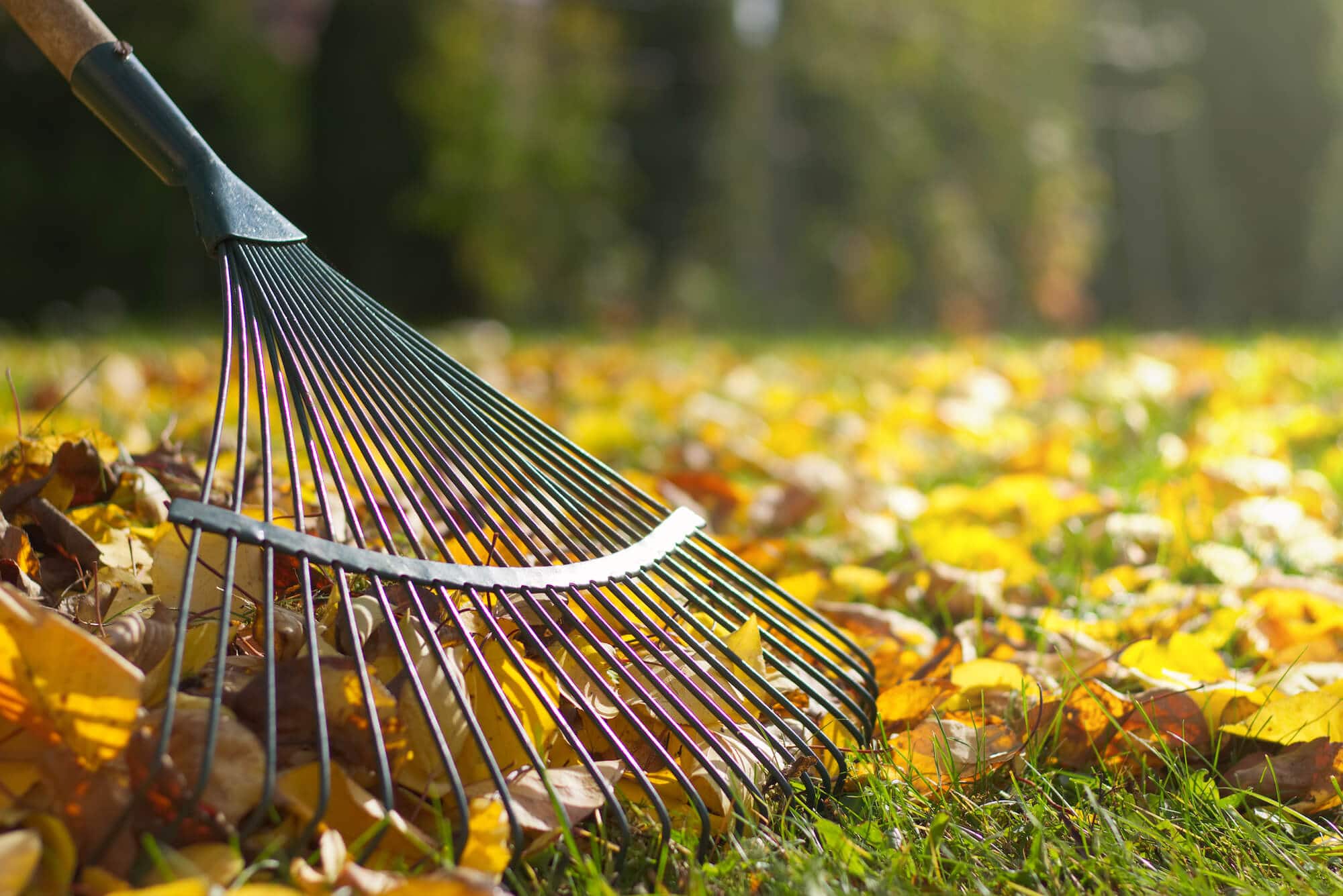How to Care For Your Lawn in the Fall
Your lawn has made it past the intense peak of summer, and the cooler fall month brings a welcomed respite to the busy lawn care schedule. The never several months, however, are an excellent time to focus on fortifying your grass and soil to get your turf ready for the long, dormant months ahead.
Your fall lawn regiment should shift focus from general management to providing much-needed care and strengthening. Many of these tips below are not unlike many of the tasks you completed in the spring to ensure the health of your turf after extreme weather.
Read on to learn about the best place for early, mid, and late fall lawn care. This way, it’s much easier to mark your calendars and feel confident that your lawn is ready for the snow ahead.

The Great Rake Debate
Before we dive into the month-by-month strategy, let’s talk about leaf removal.
Depending on where you look, experts are typically torn between whether raking up all the fallen leaves in the fall is best for your lawn and the environment. Constant leaf blowing is not often considered necessary or energy-efficient, especially early in the season, for example.
This side of the debate also argues that leaving fallen foliage on your grass naturally acts as fertilizes as it decomposes into compost.
While a small covering of leaves can provide a safe level of compost, a thick layer may be counterproductive, especially on top of cool-season grasses. For example, fescue or Kentucky bluegrass—both cool-season grasses—thrive as the weather cools down in these fall months and shouldn’t be covered under a layer of leaves.
A dense layer of foliage will keep sunlight from reaching your grassroots and trap unwanted moisture from evaporating. This moisture can lead to significant fungus and rot, especially once the snow comes.
Finding this delicate balance between letting the leaves decompose and protecting your grass is tricky. We recommend erring on the side of caution and removing leaves whenever they create a thick layer on your lawn, especially toward the end of the season.
Early Fall Lawn Care
Heading into September doesn’t always indicate a significant shift in temperature, but you may see an uptick in rain depending on your region. Switching to early fall requires a few simple steps in lawn care that we’ve included below.
1. Adjust Your Mower Blades
Your grass, especially cool-season grass, is likely to keep growing with great vigor until the cold temperatures and the first frost arrive. Still, it’s time to start cutting your lawn a bit lower than you did in the summer to avoid too dense a layer of grass. Now is the time to let the air flow freely to your thatch and roots to avoid fungus and pests.
Lower your mower blades to two-to-three inches in height, and stick to only removing the top third of your grass blades. As the autumn carries on, lower your blades another inch when the cold weather comes.
2. Alter Your Watering Schedule
Similar to the summer, your grass should receive about an inch of water each week to remain lush and strong without creating too damp an environment throughout the day. While this is still the case in the fall, an increase in precipitation may do some of the work for you.
On the other hand, be aware that early fall typically requires just as frequent and similarly timed watering as in the summer. The sun is still quite intense and water will still evaporate at a rapid rate. Stick with watering your lawn once a week in the early morning or late afternoon.
Once the temperature drops for good, lower your water frequency and check the soil for signs of proper moisture. If your grass is spongy to the touch, you’re suddenly fighting back weeds, or you’ve spotted yellow spots from common grass fungi, cut back even further.
3. Check Out Your Soil
If your grass began to struggle through the summer, the fall is a good time to analyze your soil and check if the harsh weather did a number on its pH. You can purchase a pH soil test online or speak with your local lawn care team of specialists.
This team can also advise you on adding a layer of either lime or sulfur to balance out any pH problems.
Mid-Fall Lawn Care
By the end of September and into early October, the leaves will quickly begin to fall, adding a whole new element to your lawn care routine. As we mentioned above, there’s no reason to remove every leaf from your lawn the moment it falls. Building a good schedule of raking and additional lawn healthcare will simplify the middle of the season significantly.
1. Weed One Last Time
If you spend most of the summer pulling up weeds, they should begin slowing down in October. Now’s the time to truly get ahead of them and pull them up by the roots before they go dormant and prepare to reappear next season.
Target specific patches of weeds with post-emergent products or pull them up manually, ensuring that you get the full root at the same time. Reseeding and proper fertilizer will encourage strong grass growth over the rest of the fall, filling in the spaces where weeds have pushed their way through.
2. Dethatch
Particularly hot and humid summers can lead to an overgrowth of thatch—the natural barrier that forms between your soil and grass blades. You should always have about half an inch of thatch, but an unhealthy biome can lead to your thatch becoming overgrown.
Much like the thick piles of leaves we mentioned earlier, overly thick thatch can keep sunlight, water, and nutrients from reaching the base of your grassroots.
Dethatching entails using a motorized detacher—also called a vertical mower or vericutter—or a handheld dethatching tool. Both aim to break up the thatch to allow air and sunlight to reach the base of the roots. As the turf and moisture regain their balance, the thatch should only regrow to a healthy thickness.
3. Aerate
Aeration is the process of breaking through dense soil or removing small cores of soil, thatch, and roots. This is best when your soil becomes over-compacted in the summer and early fall and it is not choking out the grass, leading to dark spots.
Aeration can also be completed in the spring or later summer as well, and is typically only necessary once a year at most. Fall aeration is best after a very active summer on the lawn especially if seasonal furniture or playsets damage an area that requires re-seeding.
4. Overseed
Early October may be your final chance to overseed if you feel your lawn needs it this year. Overseeding is typically necessary after a hard season of fighting back weeds, treating dry spots, or dealing with pests.
Speak with your local TruGreen team about the best combination of grasses for your lawn—either matching your current mix or adding a few heartier varieties that can strengthen your turf.
Overall, it’s best to overseed after you’ve completed dethatching and aerating to make sure the ground is ready to receive the new seed. Also be sure to keep the ground moist during the seed’s germination period.
5. Fertilize Cool-Season Grasses
As we mentioned above, cool-season grasses—those grown in the majority of the northern half of the country—enjoy a peak growing season in the fall as the weather cools. Before leaves begin to fall with urgency and at least eight weeks before the first frost, consider a layer of cool-season fertilizer for your lawn.
Fertilizer contains a mixture of nitrogen, potassium, and phosphorus—all of which either help in the plant’s growth and photosynthesis process or with its ability to fight off disease. Fall fertilizers typically include a mixture to help your grasses store up food for the winter ahead. Be sure not to over-fertilize your fall lawn—the treatment is meant to help the grass store nutrients for the winter, not grow quickly in the immediate future.
As an eco-friendly tip, avoid distributing fertilizer within five feet of the edges of your lawn or near a source of water, as runoff can be harmful.
Also, if frost is set in early, especially by the end of October, skip fertilizing to allow your lawn to enter its dormancy period.
Late Fall Lawn Care
The final weeks of fall—which typically take up the final months before snow or heavy frost—all revolve around winterizing your lawn. Particularly in colder, northern areas, winterization involves cutting your grass down to a shorter level, keeping up with debris, and ensuring it has enough water before the ground freezes.
1. Let it Rest
When the cold weather arrives and your grass goes dormant, it is best to give it space to rest undisturbed. Limit walking on your grass or leaving out tools and machinery that can compact the soil. Extremely wet lawns—from the rainy fall season or recent snow and sleet—can also cause the soil to shift, encouraging erosion.
2. Drain Your Irrigation System
At this point in the year, there should be enough precipitation to avoid frequent lawn watering. If you do need to water—after an odd dry spell, for example—do so sparingly.
Generally, however, November is a good time to dismantle and drain your irrigation system, whether it be a set of automatic sprinklers or a hose. Follow the detailed instructions of your unique system and speak with a landscape and sprinkler professional if you’re in doubt. Shut off the water to the system once it is properly dismantled.
3. Clear Away Debris
November can be much harsher on trees once the leaves have fallen. Clean away any fallen sticks and branches that could end up getting covered with snow during the winter.
As for the piles of leaves, check with your local community about composting pick-ups, or compost the leaves yourself by following a composting guide as they break down throughout the winter.
4. Pack Up Your Tools
As this active season of lawn care comes to a close, take the time to look at your lawnmower, gardening tools, and other special equipment. Store each item in a closed area away from moisture and snow and have machinery tuned-up if necessary.
You can also take this chance to break out the snowblower for a tune-up at your local hardware store. Ensure that you have plenty of salt, car de-icer, and strong shovels for any snowstorms just around the corner.
Expert Fall Lawn Care Assistance
It’s not uncommon to still have a lot of questions about your lawn care, especially during the spring and fall shoulder seasons. Many of these lawn care items are dependent on your type of grass, your hardiness planting region, and any health issues with your specific landscape.
There’s no reason to go it alone when determining the best next steps to care for your lawn. TruGreen offers highly trusted and eco-conscious lawn care services to homeowners across the country.
Most importantly, we understand that flexibility is key when choosing the best lawn care plan for your budget and lifestyle. Our experts can assist with year-round comprehensive maintenance, seasonal turf care, and for the harder jobs like aeration and overseeding.
Speak with a TruGreen expert today for a free lawn care consultation and an estimate to care for the health of your fall lawn.







